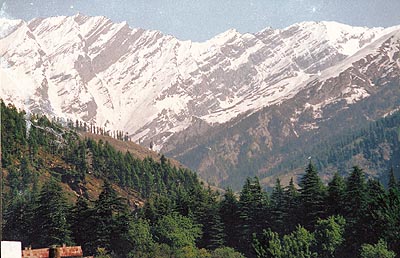A paradise
for nature lovers
Getaway
By Bijender
Sharma
THE spectacle of a goat and a lion
drinking water from the same pond at the same time may be
having roots in utopia. But if you are interested in
catching a rare sight of a Bharal and Himalayan Thar
living alongside, Kulu is the only place in the entire
Himalayas you need to head for. The Great Himalayan
National Park near Manali in Kulu district assures you of
this unparalleled view.

With a complete ban on shikar
for over a decade, Himachal Pradesh has become an abode
of wild animals. Enriched with flora, the park houses
more than 300 species of birds and over 30 species of
mammals.
Sprawled over an area of
765 sq. km, the park harbours some of the endangered
species of pheasants and mammals, including western
tragopan, musk deer and snow leopard. The park has the
largest remaining population of Himalayan Thar in India.
About one third of the
park area is covered with canopy forests that includes
chir pine, conifers, rhododendron and juniper sepcies.
The stillness at the oak forest, which is at a lower
altitude, is worth experiencing. Alpine meadows hold a
diversity of herbacious species, many of which have
medicinal and aromatic properties and are of great
commercial value.
The park consists of the
upper catchment areas of Tirthan, Sainj, Parvati and
Jiwanala. It is contiguous to the Rupi Bhaba Sanctuary in
the south-east, Pin Valley National Park in the east and
Kanawar wildlife sanctuary in the north.
A project aided by World
Bank for "Conservation of bio-diversity" has
been launched. The project has three main components,
namely eco-development, protected area management and
research, monitoring and evaluation for which Rs 3.91
crore, Rs 1.96 crore and Rs 0.64 crore, respectively, has
been earmarked.
Under the umbrella of
eco-development, work on biomass generation through tree
and fodder plantation, income generation through setting
up of small-scale industries, mitigation of adverse
effects of wildlife, infrastructural improvement and
development of eco-tourism is being carried out.
Protected area
management is being ensured by development of visitor
centres, fire watch towers and communication.
Research,monitoring and
evaluation include studies on vegetation, cultivation of
medicinal herbs, social anthropology, crop protection and
experimental slope stabilisation. The knowledge of the
local people regarding the use and value of medicinal
plants is being tapped and documented.
The bewitching scenic
beauty of the park is a complement to its biological
richness. This has made it a virtual paradise for
nature-lovers, who throng the place in large numbers.
Entry and movements in the park are restricted to day
time only. The department provides the services of a
guide to the visitors. There are 14 inspection huts
inside the park for visitors. Though there are no
hideouts and observation towers inside the park, the
undulating terrain offers vantage points for observing
wildlife.
The best period for
visiting the park is from April to June and from October
to November, when the weather and visibility are good.
But it has been observed that even the rainy season does
not dampen the spirit of visitors to the land of rich
flora and fauna. 
|

![]()

